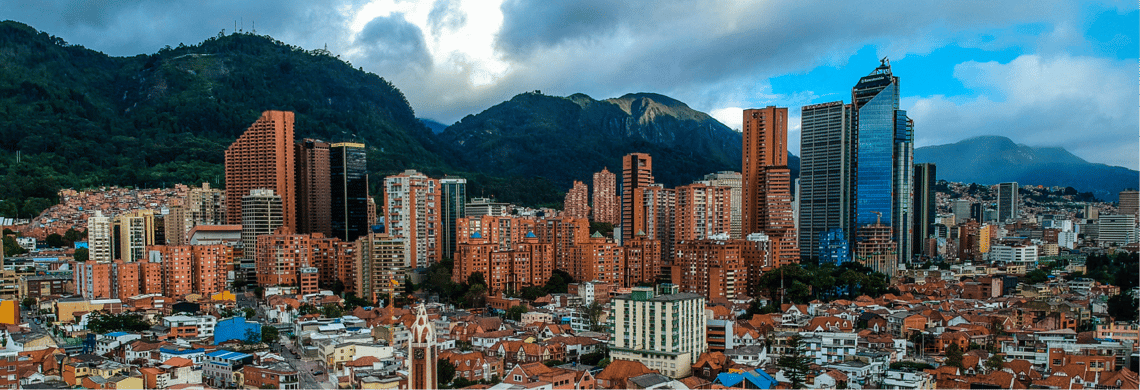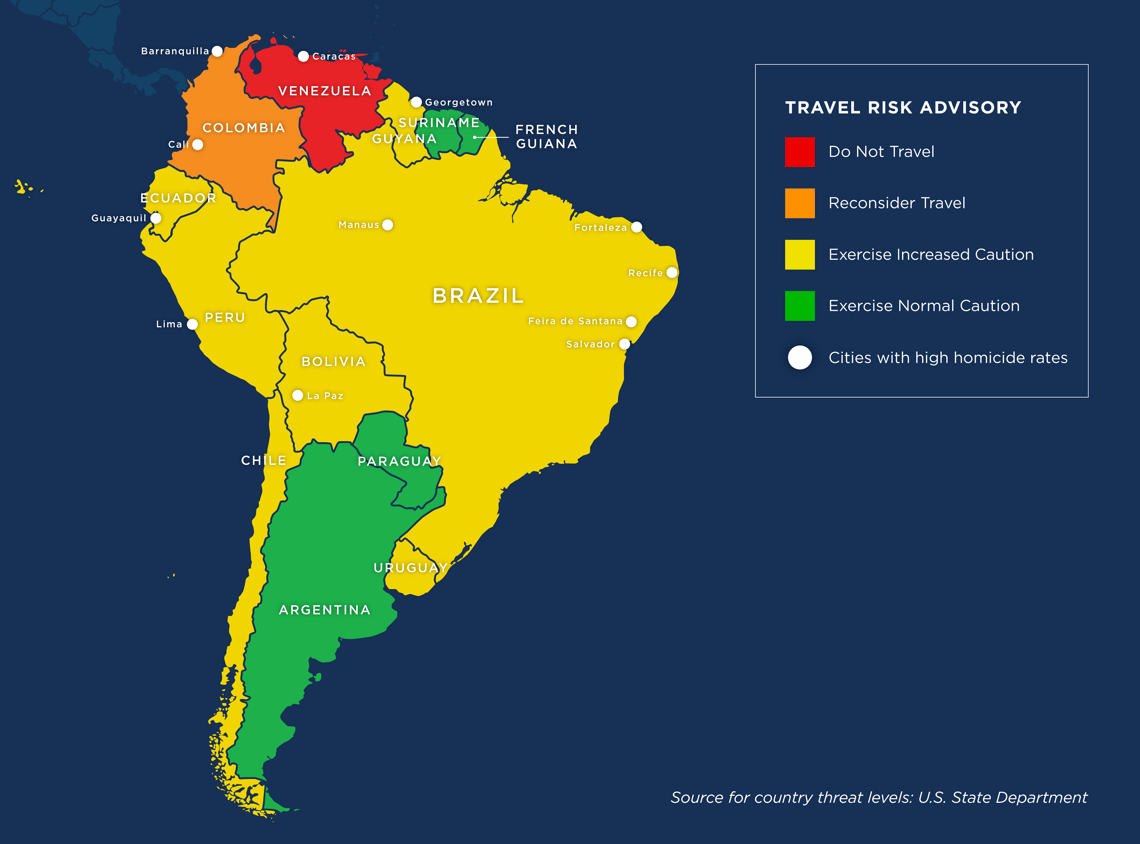Safety across South America varies significantly from one country to another, influenced by different factors like political stability, crime rates, and local laws.

|
Updated: January 2, 2025 INSIDE THIS ARTICLE, YOU'LL FIND: |
South America offers diverse travel experiences, from majestic mountains and beautiful beaches to cities filled with culture and nightlife, not to mention a range of business opportunities. However, safety concerns are a significant issue for both first time and seasoned travelers, and security risks vary greatly across the region.
Below, Global Guardian's intelligence analysts will assess safety levels, clarify misconceptions, and provide practical safety tips for visitors to the region. While it’s impossible to paint an entire continent with one brushstroke, there are common themes, confirmed assessments, and other information that can help inform any trip to South America.
Is South America Safe?
Safety across South America varies significantly from one country to another, influenced by different factors like political stability, crime rates, and local laws.
Generally, most tourist-frequented areas are safe, but some regions do pose higher risks due to various issues ranging from petty crime to more severe incidents like kidnapping and armed robbery.
Key Factors Affecting Safety
- Political stability: Countries with stable governments and less corruption tend to have better security and lower crime rates. Travelers should stay updated on current political climates, especially regarding any recent changes that might affect security such as upcoming elections.
- Crime rates: Urban areas, particularly in large cities like Bogotá and Rio de Janeiro, often experience higher crime rates. It’s important for travelers to be aware of common crimes such as pickpocketing and muggings. Ecuador and Venezuela had the highest homicide rate in 2023 in South America; however, both countries saw violent crime drop overall in 2024 due to security crackdowns and gang reorganizations.
- Local laws and law enforcement: The presence and efficacy of local law enforcement can greatly influence safety. Areas with more visible police presence and stricter enforcement of laws tend to be safer for travelers.
While these factors can serve as a general guide, it’s crucial for travelers to research specific destinations within South America to understand the localized safety conditions better. Global Guardian, as a duty-of-care provider, can provide these resources.
South America: Threat Levels by Country and City
The U.S. State Department provides the following country travel safety ratings, on a scale of one through four, for South America:
- Argentina: Level 1 (Exercise Normal Precautions)
- Bolivia: Level 2 (Exercise Increased Caution)
- Brazil: Level 2 (Exercise Increased Caution)
- Chile: Level 2 (Exercise Increased Caution)
- Colombia: Level 3 (Reconsider Travel)
- Ecuador: Level 2 (Exercise Increased Caution)
- French Guiana: Level 1 (Exercise Normal Precautions)
- Guyana: Level 3 (Reconsider Travel)
- Paraguay: Level 1 (Exercise Normal Precautions)
- Peru: Level 2 (Exercise Increased Caution)
- Suriname: Level 1 (Exercise Normal Precautions)
- Uruguay: Level 2 (Exercise Increased Caution)
- Venezuela: Level 4 (Do Not Travel)
Map of South America by Travel Risk Advisory

Safety by City in South America
While countries like Brazil and Ecuador are only a Level 2 – Exercise Increased Caution — according to the U.S. State Department, they contain some of the most violent cities in the world, demonstrating the level of nuance required when assessing safety by country and region. South American cities with some of the world's highest per capita murder rates are listed below.
Most dangerous cities in South America (by homicide rate)
- Manaus, Brazil
- Fortaleza, Brazil
- Salvador, Brazil
- Feira de Santana, Brazil
- Recife, Brazil
- La Paz, Bolivia
- Barranquilla, Colombia
- Bogota, Colombia
- Cali, Colombia
- Guayaquil, Ecuador
- Georgetown, Guyana
- Lima, Peru
- Caracas, Venezuela
- Guyana, Venezuela
Safest Cities in South America
By contrast, certain cities in South America are renowned for their commitment to and execution of safety measures, as well as being situated in more stable countries. These include:
- Buenos Aires, Argentina
- Santiago, Chile
- Asuncion, Paraguay
- Montevideo, Uruguay
Factors Contributing to Safety in South America
The safety of travelers in South America is shaped by diverse factors, which vary from one country to another. Here are some specific examples that illustrate how different countries address these concerns:
Government Initiatives and Law Enforcement Measures
In Colombia, the government has implemented special “tourist police” (Policia de Turismo) units in major cities like Bogotá and Cartagena. These units focus on areas with high tourist traffic, aiming to enhance safety and assist visitors with any issues they may encounter. Similarly, Peru has tourism police departments that specialize in helping tourists, particularly in popular destinations like Lima and Cusco.
Economic Stability and Development
Chile stands out for its economic stability in the region, which correlates with its lower crime rates compared to neighbors. This stability has allowed for significant investment in infrastructure, contributing to safer travel conditions within the country. In contrast, countries experiencing economic fluctuations, like Argentina, may see variable crime rates that can affect safety perceptions.
Cultural Attitudes Towards Crime and Safety
Uruguay is known for its relatively low tolerance for corruption and crime, which is reflected in its consistently high rankings for safety among South American nations. The country's strong legal system and societal emphasis on law and order make it one of the safer destinations for travelers.
Infrastructure and Tourism Facilities
Brazil has invested heavily in tourism infrastructure, especially in preparation for events like the 2016 Olympics. Cities like Rio de Janeiro have upgraded their public transportation systems and increased security in tourist-frequented areas. However, travelers are advised to stay vigilant as the city still grapples with high crime rates in certain areas, particularly gang-controlled favelas.
Common Myths About Safety in South America
Misconceptions about safety can significantly influence travelers' perceptions and decisions. Here, we address some common myths and provide the facts to ensure a well-informed view of traveling in South America.
Myth: All of South America is dangerous.
Fact: Safety varies widely across the continent. For instance, Uruguay and Chile consistently rank as some of the safest countries in Latin America, thanks to their stable economies and effective law enforcement. In contrast, certain areas in Venezuela, Brazil, and Ecuador may present higher risks due to economic instability and higher crime rates.
Myth: Petty crime is the only concern.
Fact: While petty crimes like pickpocketing and purse-snatching are prevalent, especially in crowded tourist spots, there are regions where more serious crimes, such as armed robbery or assault, can occur. However, with proper precautions and situational awareness, the risk of encountering these more severe crimes can be significantly reduced.
Myth: Tourist areas are always safe.
Fact: Although tourist areas are generally well-patrolled and considered safer, they can also attract criminals targeting unsuspecting tourists. For example, in popular cities like Buenos Aires and Rio de Janeiro, tourists should remain alert and safeguard their belongings, even in areas with a heavy police presence.
Important Safety Considerations for Travelers to South America
When traveling through South America, there are several safety considerations that should be prioritized to ensure a secure experience. Here are some tailored recommendations for both business and leisure travelers:
Safety For Business Travelers
- Understand the local business culture: Knowing the business etiquette and security practices can greatly reduce risks. For instance, in cities like São Paulo, it is common for businesses to employ security measures that might seem stringent but are routine locally, such as armed guards, surveillance cameras, and secondary doors with buzzers.
- Use trusted local contacts: Leveraging local knowledge through trusted business partners can help navigate safer routes and recommend secure accommodations and meeting venues.
- Stay in secure accommodations: Choose hotels with robust security measures. Many hotels in major cities across South America offer enhanced security, including access controls, security personnel, and surveillance systems.
Safety for Corporate Security Managers
- Pre-travel briefings: Offer comprehensive pre-travel safety briefings for employees traveling to high-risk areas, including emergency response strategies and contact information for local embassies or consulates.
- Continuous monitoring: Utilize travel security services that monitor the safety conditions in real-time, providing updates and advisories as needed.
- Health and medical preparedness: Ensure that travelers are aware of health risks and have access to quality medical care. This includes vaccinations, information on local health care services, and insurance that covers medical evacuation if necessary.
Safety For Leisure Travelers
- Research your destination thoroughly: Before traveling, get up-to-date information about the safest areas to visit and those to avoid. Travel forums and government travel advisories are valuable resources.
- Keep a low profile: Avoid displaying signs of wealth, such as wearing expensive jewelry or carrying high-end electronic devices in public, to not attract attention.
- Plan transportation in advance: Use reputable transportation services, especially in countries where ride-sharing apps provide an additional layer of safety through tracking and driver identification; or consider a ridesharing alternative.
By considering these specific needs and applying these guidelines, both business and leisure travelers can enhance their safety while exploring the diverse and enriching experiences that South America has to offer.
Traveling in South America comes with a unique set of safety challenges. By understanding the varying threat levels across countries, debunking common misconceptions, and adhering to specific safety considerations and tips, travelers can significantly enhance their security. Whether you are a business traveler, a leisure tourist, or a corporate security manager, being well-prepared and informed is key to navigating the continent safely.
StandinG By to Support
The Global Guardian team is standing by to support your duty of care and security requirements with a comprehensive suite of solutions. To learn more about our services, complete the form below or call us at + 1 (703) 566-9463.



